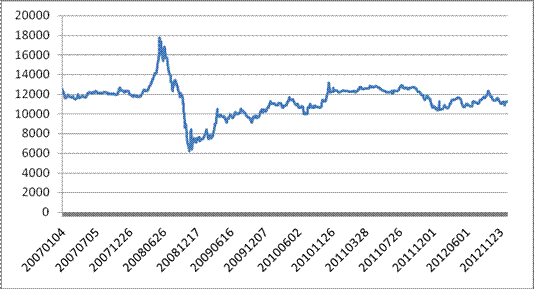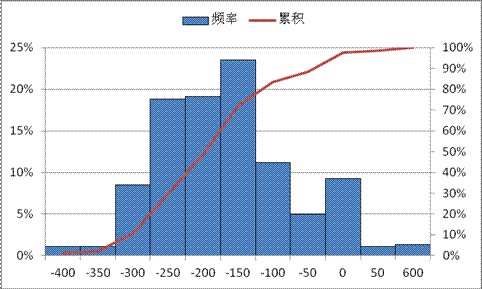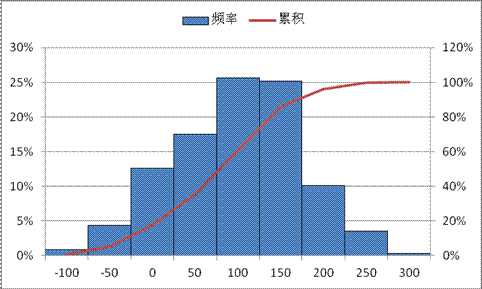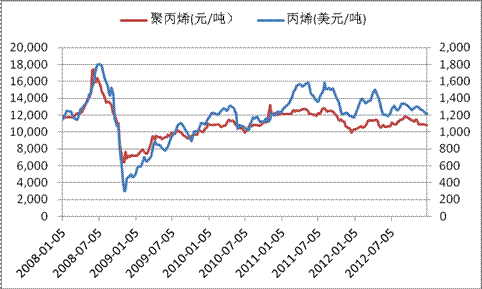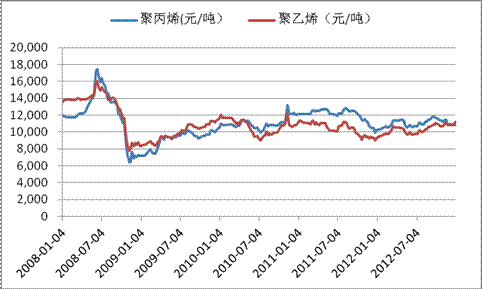Chapter VII Analysis of China's Polypropylene Price Fluctuation
7.1 Analysis of Polypropylene Price Law
7.1.1 Analysis of domestic polypropylene price fluctuation
The price of polypropylene in China fluctuates violently. Since 2007, the price of PP has been rising along with the price of crude oil, and reached the highest point in June 2008. Then, with the outbreak of the financial crisis, the price plunged sharply. In 2007, the average annual price of polypropylene in China was 12009 yuan/ton, and in June 2008, the highest price rose to about 16800 yuan/ton, up nearly 40%. Large price rises and falls are basically consistent with the trend of crude oil. From the perspective of the fluctuation in the year, the fluctuation is also quite intense. Affected by the financial crisis, the situation in 2008 was quite special, with the maximum of 17000 yuan/ton and the minimum of 6400 yuan/ton, and the price fluctuation of 10000 yuan/ton. Even in ordinary years, the price fluctuation is also large, about 47% in 2009, 33% and 29% respectively in 2011. In 2012, affected by the large number of new domestic PP units put into production, the amplitude decreased to 18%.
Table 41 Price Trend of Polypropylene in China over the Years (yuan/ton)
7.1.2 Analysis of polypropylene price between regions in China
At present, China Plastic There are two centralized distribution trade areas in the spot market. One is Yuyao market in East China, and the other is Dongguan area in Shunde, South China. In addition, Qilu Chemical City in North China has developed rapidly in recent years, becoming the price center of plastic trade in North China. On the whole, plastic traders in North China are small.
Data description: PP is wire drawing material; The statistical time is from January 1, 2012 to December 31, 2012.
(1) Regional price difference between North China and East China
According to the statistics of daily price data in 2012, the average price difference between North China and East China is about - 159 yuan/ton, and the standard deviation is 187.36.
Chart 42 Statistical table of price difference between North China and East China of brushed PP (a)
| median |
average value |
standard deviation |
kurtosis |
skewness |
minimum value |
Maximum |
| -150 |
-159.2 |
one hundred and twenty-seven point eight |
seventeen point eight |
two point eight |
-400 |
six hundred |
Chart 43 Statistical table of price difference between North China and East China of brushed PP (b)
| Price difference |
frequency |
accumulate |
| -400 |
1.09% |
1.09% |
| -350 |
1.09% |
2.19% |
| -300 |
8.47% |
10.66% |
| -250 |
18.85% |
29.51% |
| -200 |
19.13% |
48.63% |
| -150 |
23.50% |
72.13% |
| -100 |
11.20% |
83.33% |
| -50 |
4.92% |
88.25% |
| zero |
9.29% |
97.54% |
| fifty |
1.09% |
98.63% |
| six hundred |
1.37% |
100% |
Table 44 Distribution of Price Difference between North China and East China of Drawing Grade PP
(2) Regional price difference between South China and East China
The statistical results show that the average price difference between South China and East China is about 99 yuan/ton, and the standard deviation is 74.6.
Chart Statistical table of price difference between South China and East China for 45 brushed PP (a)
| median |
average value |
standard deviation |
kurtosis |
skewness |
minimum value |
Maximum |
| one hundred |
ninety-nine |
seventy-four point six |
two point seven |
-0.2 |
-100 |
three hundred |
Chart 46 Statistical table of price difference between South China and East China of brushed PP (b)
| Price difference |
frequency |
accumulate |
| -100 |
0.82% |
0.82% |
| -50 |
4.37% |
5.19% |
| zero |
12.57% |
17.76% |
| fifty |
17.49% |
35.25% |
| one hundred |
25.68% |
60.93% |
| one hundred and fifty |
25.14% |
86.07% |
| two hundred |
10.11% |
96.17% |
| two hundred and fifty |
3.55% |
99.73% |
| three hundred |
0.27% |
100% |
Table 47 Distribution of Price Difference between South China and East China of Drawing Grade PP
7.2 Price correlation between polypropylene and upstream raw materials
Introduction to the industrial chain: Polypropylene comes from crude oil, and its industrial chain is as follows: crude oil is processed into gasoline, diesel, kerosene and other products and naphtha through the refining unit, and naphtha is produced into olefins and benzene through the cracking unit, of which the production ratio of ethylene and propylene is about 5:3 (that is, 0.6 tons of propylene is generated at the same time for each ton of ethylene produced, and the ratio fluctuates between different units), Ethylene is mainly used to produce polyethylene, and propylene is used to produce polypropylene.
Crude oil naphtha: from the perspective of naphtha production, it is all produced through refining, and its yield is limited by the crude oil composition. In addition, since the crude oil is a mixture, the naphtha yield is not only limited by the crude oil composition, but also adjusted within a certain range according to the demand changes of products such as refined oil and ethylene. Globally, the output proportion of naphtha is about 17-18%. The average gross profit rate of naphtha in the world is basically 35-50 US dollars/ton (i.e. naphtha processing cost).
Olefin polyolefin: ethylene and propylene are almost 100% used to produce polyethylene and polypropylene. 1.01 tons of ethylene is consumed for 1 ton of polyethylene, and the relationship between homo polypropylene and propylene is almost 1:1. The proportion of ethylene and propylene consumed by co polypropylene is about 2:8.
7.2.1 Correlation between polypropylene and crude oil price
From the price trend of polypropylene and crude oil from 2008 to 2012, crude oil is at the front end of the industrial chain, so the price is more sensitive, and the price fluctuation is more violent than polypropylene. However, the trend of the two is basically the same, and the rising and falling time points are basically the same.
Chart 48 Price Trend of Polypropylene and Crude Oil
7.2.2 Price correlation between polypropylene and propylene
According to the price trend chart of polypropylene and propylene in the same period from 2008 to 2012, they can basically rise and fall at the same time from the time point. The price difference between the two is about 50 dollars/ton in the period of stable price, and will further narrow in the process of sharp decline or rise. In addition, it is worth noting that since propylene is basically used to produce polypropylene, the price fluctuation of propylene is more affected by the upstream raw materials and the demand for other related products, such as ethylene and refined oil.
Table 49 Price Trend of Polypropylene and Propylene
7.3 Price correlation analysis of polypropylene and polyethylene
Polypropylene and polyethylene both come from petroleum, and ethylene and propylene are symbiotic. Their price trends are basically the same. The price correlation coefficient from 2008 to 2012 is about 0.79.
Chart 50 Price Trend of Polypropylene and Polyethylene
7.4 Analysis of Factors Influencing the Price of Polypropylene in China
7.4.1 Impact of raw material price
(1) Impact of crude oil
International crude oil is an important indicator to measure the economic prospects. People often make judgments on the future economic situation through the fluctuations of international crude oil. The changes in international crude oil prices have a profound impact on the trend of the entire plastic market, including polypropylene, but most of them are reflected in the impact on the market mentality, and have little impact on the transmission of cost factors. The impact of the fluctuations in international crude oil prices on domestic costs is about 2-3 months. The rise of international crude oil has, to some extent, boosted the mentality of market merchants and downstream manufacturers, improved market popularity and increased market inquiries; The continuous rise of international crude oil will increase the market quotation and improve the market turnover. The decline of international crude oil has hit the mentality of market merchants and downstream manufacturers to a certain extent, making the wait-and-see atmosphere in the market continue to be strong, the willingness of downstream customers to receive goods decreases, and the market inventory increases, which increases the pressure on traders; The continuous decline of international crude oil will continue to increase the pressure on traders to ship, resulting in a decline in market quotations and low market turnover.
(2) Effect of propylene monomer
As the direct raw material of polypropylene, propylene monomer mainly affects the production cost of polypropylene and whether the unit can start normally. However, because propylene monomer is greatly affected by crude oil fluctuations, market merchants and downstream manufacturers tend to pay more attention to international crude oil than propylene monomer, which makes the impact of propylene on the market price of polypropylene not obvious in the market. In the market, it often happens that petrochemical enterprises stop their plants to wait for materials, which reduces the supply of a certain brand of goods, and the price of that brand of goods in the market rises. Therefore, the main factor of propylene monomer in the market is whether it can ensure the normal operation of petrochemical units.
7.4.2 Impact of downstream consumption on polypropylene price
Since the end of last century, China's PP product structure has gradually moved closer to the international consumption structure. In the market of woven products, domestic materials dominate. Most of the plastic woven bags produced with imported materials are used for export, with only a small amount sold domestically. Although the absolute consumption in this field is very large, its proportion in the total consumption of PP is decreasing year by year, from 48% in 2006 to 42% in 2012. Large, heavy, high-strength, anti-static, anti-aging and other packaging bags will be the overall development trend of woven products in the future.
At the same time, among the downstream products of PP, the consumption of fiber and injection molded products is growing at a double-digit rate year by year. In the fiber products market, most of the middle and low grade products are made of domestic materials, and the raw materials needed for the production of fine denier, super fine denier, thin non-woven fabrics, strong filament and other high-end polypropylene products are mainly imported. It is expected that the proportion of PP consumption in fiber products in its total consumption will increase from about 11% in 2006 to about 14% in 2015.
In the injection molding product market, domestic materials and imported materials are evenly divided. Domestic materials occupy the middle and low end market, while imported materials occupy the high-end market, such as thin-wall injection molding materials urgently needed in the market. The injection plastic market has huge potential, and the consumption is expected to increase from 1.5 million tons in 2006 to 3.5 million tons in 2015. In addition, the market prospect of special materials for blow molding containers, special materials for high flow and high impact resistant automobiles, BOPP heat sealing film, special materials for BOPP high-speed production line with a linear speed of more than 400m/min, pressure resistant pipes, etc. is broad.
In the general material market with huge market capacity, the competition between domestic materials and imported materials is very fierce; In the special material market with relatively small capacity, imported materials are the best. The high-grade special materials for auto parts, various household appliances, etc. are mostly imported in the form of material processing. The requirements for product added value and quality are high, and the materials used are relatively fixed. It is difficult for domestic materials to enter this market. In addition, PP modified material will also have a place in the domestic special material market.
7.4.3 Impact of national policies
For the plastic industry, the introduction of a policy is the vane of enterprise development, and even directly affects the development direction of the plastic industry. When the plastic industry has excess capacity, the policy of eliminating backward capacity becomes a necessity; When the financial crisis hit, the export trade of the plastic industry was greatly affected. At this time, national policies were needed to support the development of domestic demand. The relevant national policies were the guidance for the development of the plastic industry. Since China's polypropylene production capacity is insufficient and its dependence on foreign countries is about 28%, the country encourages imports. From January 1, 2008, the import tariff of resins including polypropylene was adjusted from 7.6% to 6.5%, without any other policy restrictions.
